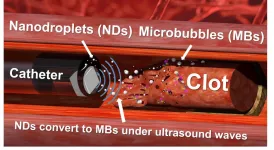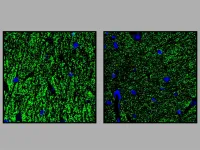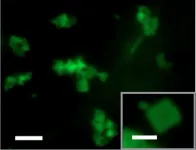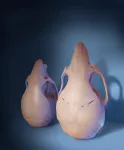(Press-News.org) Engineering researchers have developed a new technique for eliminating particularly tough blood clots, using engineered nanodroplets and an ultrasound "drill" to break up the clots from the inside out. The technique has not yet gone through clinical testing. In vitro testing has shown promising results.
Specifically, the new approach is designed to treat retracted blood clots, which form over extended periods of time and are especially dense. These clots are particularly difficult to treat because they are less porous than other clots, making it hard for drugs that dissolve blood clots to penetrate into the clot.
The new technique has two key components: the nanodroplets and the ultrasound drill.
The nanodroplets consist of tiny lipid spheres that are filled with liquid perfluorocarbons (PFCs). Specifically, the nanodroplets are filled with low-boiling-point PFCs, which means that a small amount of ultrasound energy will cause the liquid to convert into gas. As they convert into a gas, the PFCs expand rapidly, vaporizing the nanodroplets and forming microscopic bubbles.
"We introduce nanodroplets to the site of the clot, and because the nanodroplets are so small, they are able to penetrate and convert to microbubbles within the clots when they are exposed to ultrasound," says Leela Goel, first author of a paper on the work. Goel is a Ph.D. student in the joint biomedical engineering department at North Carolina State University and the University of North Carolina at Chapel Hill.
After the microbubbles form within the clots, the continued exposure of the clots to ultrasound oscillates the microbubbles. The rapid vibration of the microbubbles causes them to behave like tiny jackhammers, disrupting the clot's physical structure, and helping to dissolve the clots. This vibration also creates larger holes in the clot mass that allow blood borne anti-clotting drugs to penetrate deep into the clot and further break it down.
The technique is made possible by the ultrasound drill - which is an ultrasound transducer that is small enough to be introduced to the blood vessel via a catheter. The drill can aim ultrasound directly ahead, which makes it extremely precise. It is also able to direct enough ultrasound energy to the targeted location to activate the nanodroplets, without causing damage to surrounding healthy tissue. The drill incorporates a tube that allows users to inject nanodroplets at the site of the clot.
In in vitro testing, the researchers compared various combinations of drug treatment, the use of microbubbles and ultrasound to eliminate clots, and the new technique, using nanodroplets and ultrasound.
"We found that the use of nanodroplets, ultrasound and drug treatment was the most effective, decreasing the size of the clot by 40%, plus or minus 9%," says Xiaoning Jiang, Dean F. Duncan Distinguished Professor of Mechanical and Aerospace Engineering at NC State and corresponding author of the paper. "Using the nanodroplets and ultrasound alone reduced the mass by 30%, plus or minus 8%. The next best treatment involved drug treatment, microbubbles, and ultrasound - and that reduced clot mass by only 17%, plus or minus 9%. All these tests were conducted with the same 30-minute treatment period.
"These early test results are very promising."
"The use of ultrasound to disrupt blood clots has been studied for years, including several substantial studies in patients in Europe, with limited success," says co-author Paul Dayton, William R. Kenan Jr. Distinguished Professor of Biomedical Engineering at UNC and NC State. "However, the addition of the low-boiling point nanodroplets, combined with the ultrasound drill has demonstrated a substantial advance in this technology."
"Next steps will involve pre-clinical testing in animal models that will help us assess how safe and effective this technique may be for treating deep vein thrombosis," says Zhen Xu, a professor of biomedical engineering at the University of Michigan and co-author of the paper.
INFORMATION:
The paper, "Nanodroplet-Mediated Catheter-Directed Sonothrombolysis of Retracted Blood Clots," is published open access in the journal Microsystems & Nanoengineering. The paper was co-authored by Huaiyu Wu and Bohua Zhang, who are Ph.D. students at NC State; and Jinwook Kim, a postdoctoral researcher in the Joint Department of Biomedical Engineering at UNC and NC State.
The work was done with support from the National Institutes of Health, under grant R01HL141967.
A startup called SonoVascular, Inc., which was co-founded by Jiang, has licensed the ultrasound "drill" technology from NC State. SonoVascular and NC State are hoping to work with industry partners to advance the technology. The low-boiling point nanodroplets, co-invented by Dayton, have also been issued a U.S. patent. That technology has been licensed by spinout company Triangle Biotechnology, Inc., which was co-founded by Dayton. Study co-authors Dayton, Kim, Xu and Jiang have also filed a patent application related to nanodroplet-mediated sonothrombolysis.
PHILADELPHIA - Medical school curriculums may misuse race and play a role in perpetuating physician bias, a team led by Penn Medicine researchers found in an analysis of curriculum from the preclinical phase of medical education. In a perspective piece published Tuesday in the New England Journal of Medicine, the researchers identified five key categories in which curriculum misrepresented race in class discussions, presentations, and assessments. The authors recommend that rather than oversimplifying conversations about how race affects diseases' prevalence, diagnosis, and treatment, medical school faculty must widen the lens to "impart an adequate and accurate understanding of the complexity ...
FOR IMMEDIATE RELEASE
In what is believed to be the most comprehensive molecular characterization to date of the most common type of head and neck cancer, researchers from the Johns Hopkins departments of END ...
As the planet continues to warm, the twin challenges of diminishing water supply and growing energy demand will intensify. But water and energy are inextricably linked. For instance, nearly a fifth of California's energy goes toward water-related activities, while more than a tenth of the state's electricity comes from hydropower. As society tries to adapt to one challenge, it needs to ensure it doesn't worsen the other.
To this end, researchers from UC Santa Barbara, Lawrence Berkeley National Laboratory and UC Berkeley have developed a framework to evaluate how different climate adaptations may impact this water-energy nexus. Their research appears in the open access journal Environmental Research Letters.
"Electricity and water systems are linked in many ...
Impaired intelligence, movement disorders and developmental delays are typical for a group of rare diseases that belong to GPI anchor deficiencies. Researchers from the University of Bonn and the Max Planck Institute for Molecular Genetics used genetic engineering methods to create a mouse that mimics these patients very well. Studies in this animal model suggest that in GPI anchor deficiencies, a gene mutation impairs the transmission of stimuli at the synapses in the brain. This may explain the impairments associated with the disease. The results are now published ...
INDIANAPOLIS-- Researchers at the Indiana University Melvin and Bren Simon Comprehensive Cancer Center published promising findings today in the New England Journal of Medicine on preventing a common complication to lifesaving blood stem cell transplantation in leukemia.
Sherif Farag, MD, PhD, found that using a drug approved for Type 2 diabetes reduces the risk of acute graft-versus-host disease (GVHD), one of the most serious complications of blood stem cell transplantation. GVHD occurs in more than 30 percent of patients and can lead to severe side effects and potentially fatal results. Farag is ...
Chemists have developed a nanomaterial that they can trigger to shape shift -- from flat sheets to tubes and back to sheets again -- in a controllable fashion. The Journal of the American Chemical Society published a description of the nanomaterial, which was developed at Emory University and holds potential for a range of biomedical applications, from controlled-release drug delivery to tissue engineering.
The nanomaterial, which in sheet form is 10,000 times thinner than the width of a human hair, is made of synthetic collagen. Naturally occurring collagen is the most abundant protein in humans, making the new material intrinsically biocompatible.
"No one has previously made collagen ...
Alexandria, Va., USA -- The COVID-19 pandemic has significantly impacted dental education and training. The study "COVID-19 and Dental and Dental Hygiene Students' Career Plans," published in the JDR Clinical & Translational Research (JDR CTR), examined the short-term impact of the COVID-19 pandemic on dental hygiene and dental students' career intentions.
An anonymous online survey was emailed to dental and dental hygiene students enrolled at Virginia Commonwealth University School of Dentistry, Richmond, USA. The survey consisted of 81 questions that covered a wide range of topics including demographics, anticipated educational debt, career plans post-graduation, ...
CHAMPAIGN, Ill. -- In almost all successful advertising campaigns, an appeal to emotion sparks a call-to-action that motivates viewers to become consumers. But according to research from a University of Illinois Urbana-Champaign expert who studies consumer information-processing and memory, emotionally arousing advertisements may not always help improve consumers' immediate memory.
A new paper co-written by Hayden Noel, a clinical associate professor of business administration at the Gies College of Business at Illinois, finds that an ad's emotional arousal can have a negative effect on immediate ...
Using stem cells to regenerate parts of the skull, scientists corrected skull shape and reversed learning and memory deficits in young mice with craniosynostosis, a condition estimated to affect 1 in every 2,500 infants born in the United States, according to the Centers for Disease Control and Prevention. The only current therapy is complex surgery within the first year of life, but skull defects often return afterward. The study, supported by the National Institute of Dental and Craniofacial Research (NIDCR), could pave the way for more effective and less invasive therapies for children with craniosynostosis. ...
Humans feeding leftover lean meat to wolves during harsh winters may have had a role in the early domestication of dogs, towards the end of the last ice age (14,000 to 29,000 years ago), according to a study published in Scientific Reports.
Maria Lahtinen and colleagues used simple energy content calculations to estimate how much energy would have been left over by humans from the meat of species they may have hunted 14,000 to 29,000 years that were also typical wolf prey species, such as horses, moose and deer. The authors hypothesized that if wolves and humans had hunted the same animals during harsh winters, humans would have killed wolves to reduce competition rather than domesticate them. With the exception of Mustelids such as weasels, ...





